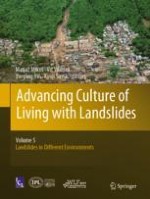2017 | OriginalPaper | Chapter
Adaptive Learning Techniques for Landslide Forecasting and the Validation in a Real World Deployment

Authors : T. Hemalatha, Maneesha Vinodini Ramesh, Venkat P. Rangan
Published in: Advancing Culture of Living with Landslides
Publisher: Springer International Publishing
Activate our intelligent search to find suitable subject content or patents.
Select sections of text to find matching patents with Artificial Intelligence. powered by
Select sections of text to find additional relevant content using AI-assisted search. powered by
